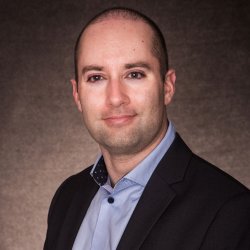Dr. Roman Bauer
Roman Bauer, Ph.D. is Computational Biologist, Lecturer, and UKRI Research Fellow at the Department of Computer Science, University of Surrey, UK.
Roman’s interests are Computational Neuroscience, Machine Learning and AI, Cryopreservation, and Cancer Research. His current focus is Models of Brain Development with devising and analyzing computational and statistical models of how tissue evolves, during the development and degeneration of the Aging Brain in order to better understand the system dynamics.
These models incorporate the interaction between cellular processes and the physical laws of the extracellular environment. Such a detailed approach is computationally very demanding, so his research also involves modern computing approaches and IT-related collaboration.
Roman uses modern computing methods to investigate how neural tissue develops, and why sometimes this process goes wrong. He is using AI, high-performance computing, machine learning, and bioinformatics tools in his research.
Roman’s work is interdisciplinary, touching upon the fields of biology, mathematics, physics, and computer science.
He is best known for his initiation and ongoing leadership of the BioDynaMo cohort. A free accessible software, the BioDynaMo platform allows computer science experts and non-experts alike to create, run, and visualize 3D agent-based biological simulations from a simple laptop. It was created in 2015, in collaboration with CERN. Its goal is to create a general Computational Biology platform for the modeling and analysis of biological tissue dynamics. Read Agent-based modeling of neuronal growth.
Roman earned his Bachelor’s Degree of Science in Computational Science and Engineering in 2007 and his Master’s Degree of Science in 2008 as well in Computational Science and Engineering with Specialization in Theoretical Physics and Robotics at ETH Zürich in Switzerland.
Roman earned his Ph.D. in Neuroscience in 2013 at the Institute of Neuroinformatics, University of Zürich and ETH Zürich under the guidance of Professor Rodney Douglas, a pioneer in neuromorphic computation and cofounder of the institute. He worked on Computational modeling of neural development, Modeling of axonal and dendritic outgrowth, Self-organization of neuronal networks, and as a Teaching Assistant in Physics.
His Ph.D. thesis explored the workings of how a smaller number of coding genes can specify a large number of Neurons and Synapses. The thesis brought the first model of cortical neural network self-organization in 3D space by a specific class of computational modeling called agent-based modeling (ABM) or individual-based modeling (IBM) – something that has become a foundational tool in his current work.
He joined Newcastle University in September 2013 as a postdoctoral research associate working in Prof. Marcus Kaiser’s Dynamic Connectome Lab on Computer simulations of neural development, AI, big data, and supervision of students.
Roman is also a member and Principal Investigator at Prof. Marcus Kaiser’s Neuroinformatics lab at Newcastle University working on a Green Brain Project, where they are simulating Human Brain Development.
Watch Detailed computational modeling of the developmental self- organization of neuronal structure and function at The International Neuroinformatics Coordinating Facility (INCF). INCF is an international nonprofit organization devoted to advancing the field of neuroinformatics and global collaborative brain research.
In September 2016, Roman started his MRC fellowship project as an independent principal investigator to computationally model the development of the retina using BioDynaMo. His work was focused on computational modeling and analysis of biomedical data (e.g. RNAseq, electrical activity, image analysis, etc.), in particular on retinal development and degeneration. Some of his publications:
- An integrated transcriptional analysis of the developing human retina (2019)
- Structural connectome centrality is a potential risk factor for progression to Alzheimer’s disease (2019)
- A generative growth model for thalamocortical axonal branching in the primary visual cortex, 2020
In June 2018 he took up an EPSRC UKRI Innovation Fellowship at the School of Computing and a joint affiliation with the Bioscience Institute (formerly the Institute of Genetic Medicine), both at Newcastle University. He proposed the use of BioDynaMo to simulate and model the retinal cryopreservation process, in particular on neural tissue. He lead an interdisciplinary lab including experimental researchers as well as computational experts, in collaboration with industry players like GE Healthcare, Intel, and CERN.
In August 2020, after seven years at Newcastle University, Roman became a lecturer and UKRI Research Fellow in the Department of Computer Science at the University of Surrey.
Intel’s Modern Code Developer Challenge used Roman’s brain simulation code to put it into the hands of hundreds of students that were involved in the competition.
In the fall of 2020, Roman was invited speaker at BioStasis2020, where he talked about Computational Methods in Cryopreservation. Read the Scholar Profile on Roman in Cryonics Magazine.
Watch the Video series on BioDynaMo based modeling and simulation of cancer growth. Watch Intel Code Modernisation Challenge: Interview with Dr Roman Bauer. Watch Simulation of a self-organizing neural network using axonal growth rules.
Visit his Home Page, LinkedIn profile, and his Work Page. Follow him on Google Scholar, ORCID, Facebook, Instagram, YouTube, and Twitter.





